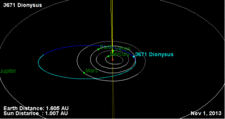3671 Dionysus
|
Orbit of 3671 Dionysus | |
| Discovery | |
|---|---|
| Discovered by | Carolyn and Gene Shoemaker |
| Discovery site | Palomar Observatory |
| Discovery date | 27 May 1984 |
| Designations | |
| MPC designation | 3671 |
Named after | Dionysus |
| 1984 KD[1] | |
| PHA[1] | |
| Orbital characteristics[1] | |
| Epoch 13 January 2016 (JD 2457400.5) | |
| Uncertainty parameter 0 | |
| Observation arc | 11629 days (31.84 yr) |
| Aphelion | 3.389527126 AU (507.0660407 Gm) |
| Perihelion | 1.00825538 AU (150.832858 Gm) |
| 2.198891253 AU (328.9494493 Gm) | |
| Eccentricity | 0.54147101 |
| 3.26 yr (1191.0 d) | |
| 244.408078° | |
| 0° 18m 8.181s / day | |
| Inclination | 13.5346771° |
| 82.1319934° | |
| 204.217348° | |
| Known satellites | 1 |
| Earth MOID | 0.0199599 AU (2.98596 Gm) |
| Jupiter MOID | 1.82836 AU (273.519 Gm) |
| Jupiter Tisserand parameter | 3.429 |
| Physical characteristics | |
| Dimensions | 1.5 km[1] |
Mean radius | 0.75 km |
Mean density | 1.6 g/cm3[2] |
| 2.7053 h (0.11272 d) | |
Sidereal rotation period | 2.7053 h[1] |
| 0.16[1] | |
| B[1] | |
| 16.5[1] | |
|
| |
3671 Dionysus is a small binary Amor asteroid, orbiting between Earth and the asteroid belt. It was discovered by Carolyn and Gene Shoemaker at Palomar Observatory on 27 May 1984. It is named after Dionysus, the Greek god of wine. Its provisional designation was 1984 KD. It is an outer Earth grazer because its perihelion is just within Earth's orbit.
Potentially hazardous object
3671 Dionysus is a potentially hazardous asteroid (PHA) because its minimum orbit intersection distance (MOID) is less than 0.05 AU and its diameter is greater than 150 meters. The Earth-MOID is 0.01989 AU (2,976,000 km; 1,849,000 mi).[1] Its orbit is well-determined for the next several hundred years.
Dionysus makes modestly close approaches to Earth. On 19 June 1984 Dionysus passed 0.0305 AU (4,560,000 km; 2,840,000 mi) from Earth.[1] On 18 June 2085 it will pass 0.028 AU (4,200,000 km; 2,600,000 mi) from Earth.[1]
Moon
In 1997, a team of astronomers at the European Southern Observatory announced that lightcurve observations indicate the presence of a small moon orbiting Dionysus. Its provisional designation is S/1997 (3671) 1. This moon measures 300 meters in diameter, and orbits 3.6 km from Dionysus with an eccentricity of 0.07 and an orbital period of 27.72 hours.[3] From the surface of Dionysus, S/1997 (3671) 1 would have an apparent diameter of roughly 3.02 degrees.[lower-alpha 1] For comparison, the Sun appears to be 0.5° from Earth.
Notes
- ↑ Calculated by solving the equation .
References
- 1 2 3 4 5 6 7 8 9 10 11 "3671 Dionysus (1984 KD)". JPL Small-Body Database. NASA/Jet Propulsion Laboratory. Retrieved 14 April 2016.
- ↑ "Photometric survey of binary near-Earth asteroids". Icarus. March 2006. Bibcode:2006Icar..181...63P. doi:10.1016/j.icarus.2005.10.014.
- ↑ Johnston's Archive: (3671) Dionysus and S/1997 (3671) 1
